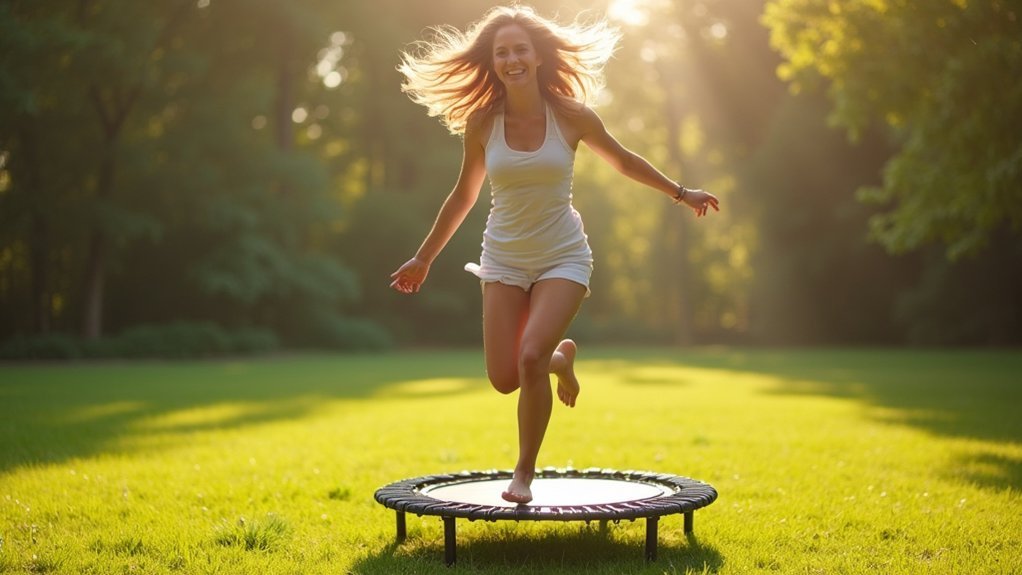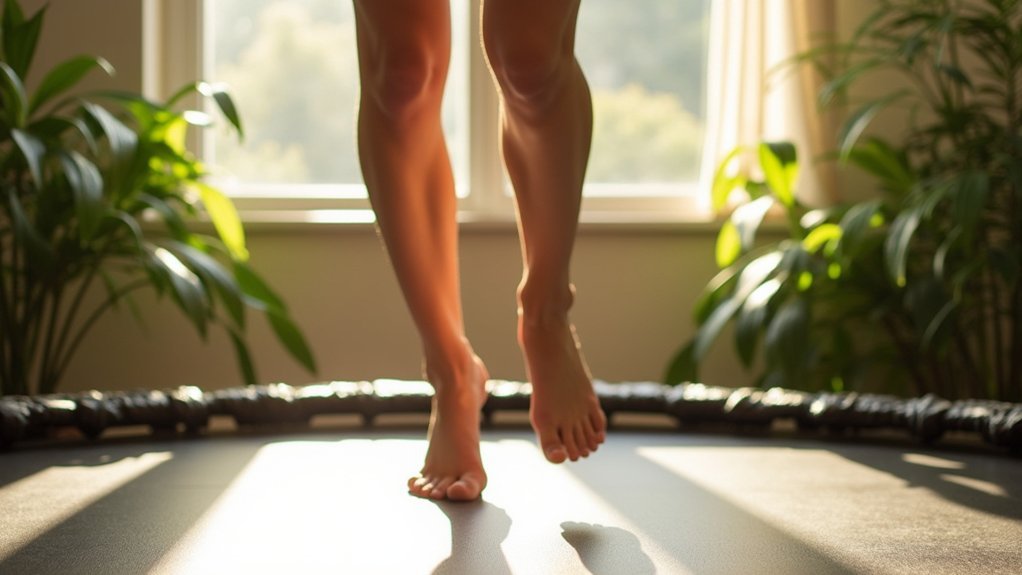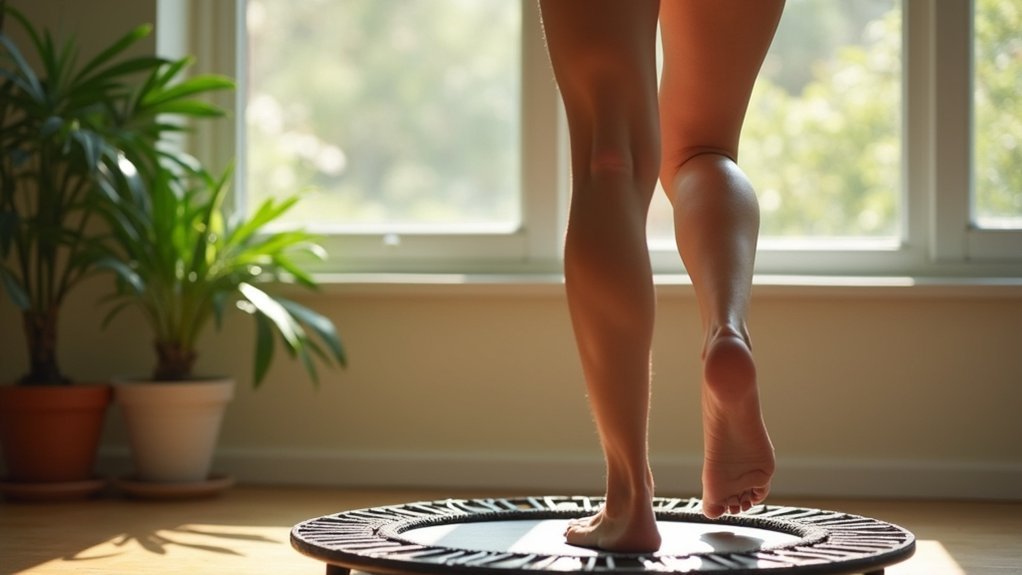Rebounding effectively targets postpartum cellulite by stimulating your lymphatic system, which flushes out toxins and reduces fluid retention. The gentle bouncing motion activates your core muscles weakened during pregnancy while improving circulation to cellulite-prone areas. You’ll need just 5-10 minutes daily for visible results, making it perfect for busy new moms. The low-impact nature protects your recovering pelvic floor while the rhythmic movements break down stubborn fat deposits that contribute to dimpled skin.
The Science Behind Postpartum Cellulite Formation

Five distinct biological processes converge to create postpartum cellulite.
First, hormonal fluctuations—especially estrogen, progesterone, and relaxin—weaken your connective tissue and alter fat distribution.
Pregnancy hormones rewrite your body’s blueprint, loosening tissue integrity while redirecting where fat accumulates.
Second, the architecture of your skin’s support structures changes as shortened septa create tethering points where fat herniates outward, forming visible dimples.
Third, pregnancy weight fluctuations increase adipose tissue in hormonally-sensitive areas like thighs and abdomen.
Fourth, compromised vascular and lymphatic systems from uterine pressure reduce circulation, causing fluid retention and tissue inflammation.
Finally, your skin’s elasticity diminishes as collagen and elastin degrade from hormonal changes.
These factors don’t work in isolation—they create a perfect storm where weakened tissue struggles to contain expanded fat cells, resulting in the characteristic dimpled appearance.
How Rebounding Activates the Lymphatic System
Rebounding creates gravitational forces that dramatically increase your lymphatic flow, functioning as a full-body pump that moves stagnant fluid through one-way valves.
Your lymphatic system responds to these gentle oscillations by flushing out protein-rich debris and cellular waste that contribute to postpartum cellulite.
Even short two-minute sessions on a rebounder can trigger lymphocytosis, enhancing your body’s natural detoxification processes while improving circulation to cellulite-prone areas.
The consistent up-and-down motion of rebounding provides lower impact exercise compared to traditional workouts, making it an ideal choice for postpartum recovery.
Lymph Flow Acceleration
Unlike conventional exercises, the unique up-and-down motion of rebounding creates powerful cellular-level changes through gravitational manipulation.
When you bounce, you generate G-forces that mechanically open lymphatic valves, creating a pumping effect that propels stagnant fluid through your system.
The alternating pressure differentials during bounce-and-land cycles force lymph toward drainage points while engaging your leg, core, and pelvic floor muscles to enhance this process.
You’ll activate superficial lymphatics with gentle bouncing, while more vigorous sessions engage deeper pathways.
This rebounding action triggers a remarkable immune response – your white blood cell count can temporarily triple, improving pathogen clearance while the mechanical stress optimizes cellular nutrient absorption and waste removal.
These mechanisms directly combat the fluid retention and metabolic byproducts that contribute to postpartum cellulite.
The gentle nature of rebounding makes it an excellent option for those seeking low-impact exercise that’s easier on the joints compared to traditional cardio activities.
Toxin Removal Process
The body’s natural detoxification pathway operates through your lymphatic system, which rebounding activates with remarkable efficiency. In just two minutes of bouncing, you’ll flush your entire lymphatic system, pulling waste from cells while forcing oxygen and nutrients in. The rapid changes in gravity during rebounding create an ideal environment for enhanced lymphatic circulation, making it particularly effective for postpartum toxin elimination.
| Rebounding Action | Detoxification Effect |
|---|---|
| Gravity alteration | Creates pumping action for lymph flow |
| Rhythmic movement | Activates lymph nodes for toxin capture |
| Cellular stimulation | Pulls out cellular waste products |
| Consistent bouncing | Maintains lymphatic efficiency |
| Low-impact motion | Enables injury-free detoxification |
Unlike high-impact exercises, rebounding provides these benefits without strain. For postpartum women, this gentle yet effective method helps clear metabolic waste and dead cells that can contribute to cellulite formation. Your body’s “garbage can” functions efficiently when you make rebounding a consistent part of your recovery routine.
Circulation Bounce Benefits
When you bounce on a mini-trampoline, your entire lymphatic system receives a powerful activation that traditional exercises simply can’t match.
The rhythmic compression and decompression created by changing G-forces stimulates lymphatic vessels, enhancing fluid movement through your body.
Each bounce creates vertical motion that replaces your missing lymphatic pump, driving lymph through one-way valves toward drainage points.
Your immune system responds dramatically—white blood cell counts can triple in just two minutes, remaining elevated for an hour afterward.
These strengthened cells more efficiently clear metabolic waste and fight pathogens.
Even brief two-minute rebounding sessions flush your entire lymphatic system while simultaneously reducing postpartum edema.
The gentle organ massage effect helps clear hormonal waste and supports uterine involution, all without stressing your recovering pelvic floor.
Rebuilding Core Strength While Reducing Dimpled Skin
Rebounding isn’t just about bouncing away cellulite—it’s a powerful way to reactivate your weakened abdominal muscles after pregnancy.
Your body’s lymphatic system benefits from the rhythmic gravitational changes during rebounding, flushing out toxins that contribute to dimpled skin.
As you strengthen your core on the mini-trampoline, you’re simultaneously triggering a natural detoxification process that can visibly reduce postpartum cellulite over time. The gentle bouncing motion can help maintain hormone balance in the postpartum period, which is crucial for both recovery and cellulite reduction.
Abdominal Muscle Reactivation
After childbirth, your abdominal muscles often need careful attention to regain their former strength and tone, especially as they relate to stubborn postpartum cellulite.
Rebounding offers a gentle yet effective way to reactivate these muscles. The continuous core engagement required to maintain balance on a trampoline strengthens your abdominal muscles while improving circulation—a key factor in reducing cellulite appearance.
You’ll find that this low-impact exercise progressively builds endurance without straining your postpartum body.
As you bounce, your core muscles continuously contract to stabilize your body, helping to reduce back pain and improve posture. This controlled movement also enhances pelvic stability, essential for your overall recovery.
When combined with proper breathing techniques and nutritional support, rebounding creates a thorough approach to rebuilding your core while diminishing that unwanted dimpled skin.
Lymphatic System Cleansing
The lymphatic system plays a fundamental role in both postpartum recovery and cellulite reduction. When you rebound, the vertical movement creates gravitational forces that simultaneously open and close lymphatic valves, enhancing fluid flow throughout your body.
This rhythmic bouncing specifically targets stagnant lymph in your thighs and buttocks—areas where postpartum cellulite commonly appears. Your body’s natural detoxification improves as rebounding flushes toxins that contribute to dimpled skin appearance.
You’ll also experience core strengthening benefits as your pelvic floor and transverse abdominis engage during bouncing. This low-impact exercise safely activates postpartum abdominal muscles while reducing intra-abdominal pressure. Most women notice a noticeable improvement in their cellulite appearance within weeks of consistent rebounding sessions.
Start with just 5-10 minutes daily, focusing on controlled movements. For enhanced results, combine rebounding with proper hydration and dry brushing before your session.
Gravitational Detox Impact
When your body experiences the alternating gravitational forces of rebounding, a powerful detoxification process begins in your postpartum tissues.
These weightless rebound intervals create upward and downward forces that simultaneously engage your core and mobilize trapped fluids contributing to cellulite.
The low-impact compression of controlled bouncing strengthens your pelvic floor without the stress of traditional exercises.
During the downward phase, gravity-aided deceleration activates your transverse abdominis, rebuilding core stability while promoting fat breakdown.
You’ll maximize results by incorporating directional shifts (side-to-side, forward-backward) to enhance oblique strength and distribute stress evenly across connective tissues.
Try angled bounce techniques while maintaining neutral spine alignment—crucial for diastasis recti recovery—to target specific problem areas like hips and thighs.
Time-Efficient Bounce Sessions for Busy New Moms
Finding time to exercise as a new mom can feel almost impossible, yet rebounding offers a perfect solution with its remarkably efficient workout format.
You’ll need just 10 minutes daily for an effective session that combines cardio, muscle toning, and detoxification all at once.
The beauty of rebounding lies in its practicality. You can bounce at home while your baby naps or plays nearby, eliminating travel time to gyms.
It’s incredibly easy to learn, requiring minimal equipment beyond the rebounder itself.
Your schedule flexibility remains intact as you can split sessions throughout the day or bounce whenever you find a free moment. This low-impact exercise is particularly beneficial for postpartum bodies that need gentle yet effective movement options.
This accessibility makes rebounding uniquely suited for new mothers juggling recovery, childcare, and the countless demands of postpartum life.
Comparing Rebounding to Traditional Postpartum Exercises

While running on hard surfaces can jar your healing body and increase pelvic floor pressure, rebounding offers 80% less joint impact while still delivering cardiovascular benefits.
Your postpartum joints and weakened connective tissues will thank you for choosing the gentle, controlled bouncing motion that protects vulnerable areas while activating deep muscles.
The trampoline’s elastic surface absorbs shock that would otherwise travel through your ankles, knees, and hips, making it an ideal low-impact alternative that won’t compromise your recovery or exacerbate diastasis recti conditions.
Rebounding vs. Running
Although many postpartum fitness programs recommend running as the go-to cardio exercise, rebounding offers distinct advantages for new mothers tackling stubborn cellulite.
While running pounds your already weakened joints, rebounding absorbs 80-90% of impact through its trampoline surface. You’ll experience less pelvic floor strain and safer post-cesarean recovery due to reduced abdominal pressure.
The vertical bouncing motion directly stimulates lymphatic drainage in your thighs and buttocks—areas where cellulite typically appears. Many users report visible cellulite reduction within just two weeks of daily 10-minute sessions.
You’ll need only 10-15 minutes of rebounding compared to running’s longer sessions, making it ideal for busy mothers. This time-efficient exercise strengthens your deep core muscles naturally through constant micro-adjustments, helping restore your postpartum body faster than traditional routines.
Low vs. High-Impact
When new mothers consider exercise options, the distinction between low and high-impact workouts becomes essential for safe postpartum recovery.
Rebounding offers gentle, controlled movements that avoid the abrupt joint compression seen in high-impact exercises like running or HIIT.
Unlike traditional workouts that generate harsh ground reaction forces, rebounding’s elastic surface absorbs impact while still providing gravitational stress benefits. This makes it ideal for postpartum bodies – you’ll strengthen your pelvic floor rather than stress it with downward pressure.
High-intensity exercises can spike cortisol and delay recovery by overwhelming your endocrine system. In contrast, rebounding supports thyroid and adrenal function without metabolic overexertion.
The vertical motion enhances detoxification and circulation while targeting deep core muscles through micro-instability – all without risking diastasis recti aggravation.
Setting Realistic Expectations: Timeline for Visible Results
Many new mothers enthusiastic to address postpartum cellulite through rebounding wonder how quickly they’ll see results.
While some benefits like improved circulation may appear after just a few sessions, visible cellulite reduction typically takes several weeks of consistent practice.
You’ll likely notice enhanced skin appearance within the first month, but significant improvements in muscle tone and weight loss generally require 3-6 months of regular rebounding.
Your timeline will vary based on your starting fitness level, session frequency, and workout intensity.
For best results, combine rebounding with balanced nutrition and consider complementary exercises.
Remember that your body’s response depends on individual factors including postpartum recovery stage.
Patience and consistency are key—the lymphatic drainage and muscle-strengthening benefits of rebounding accumulate gradually but deliver lasting improvements.
Proper Rebounding Technique for Maximum Cellulite Reduction

Mastering proper rebounding technique transforms a simple bouncing workout into a powerful cellulite-fighting regimen for postpartum bodies.
Maintain a neutral spine with ears aligned over shoulders and hips while engaging your core throughout each movement. When performing the signature Jamba Run, alternate heel kickbacks at a quick tempo while pumping your bent arms at 90-degree angles to maximize lymphatic flow. The repetitive pumping motion creates hypergravity conditions that effectively compress veins and lymph vessels to enhance drainage in cellulite-prone areas.
Proper alignment and core engagement during Jamba Runs creates the perfect environment for optimal lymphatic drainage.
- Land softly with bent knees that track over your toes to protect joints while effectively targeting thigh tissue.
- Incorporate twisting motions during bounces to activate oblique muscles and stimulate waistline circulation.
- Sustain movement for at least 7-minute intervals to create meaningful impact on cellulite-prone areas.
- Alternate high-intensity intervals (1 minute) with recovery bouncing (30 seconds) for ideal results.
Combining Nutrition With Rebounding for Enhanced Results
Optimizing your postpartum cellulite reduction requires more than just bouncing on a rebounder—it demands strategic nutritional support that amplifies your workout benefits.
Stay hydrated with at least 2.5L of water daily to maintain skin elasticity and enhance lymphatic drainage.
Time your nutrition for maximum impact: consume antioxidant-rich berries 1-2 hours before rebounding to combat oxidative stress, and prioritize lean proteins afterward to support muscle repair.
Include omega-3 sources like salmon and walnuts to reduce inflammation while phytoestrogen-rich foods help regulate hormonal imbalances contributing to cellulite.
For postpartum-specific needs, pair morning rebounding with fiber-rich breakfasts to optimize toxin clearance, and incorporate iron-rich foods like lentils to improve circulation in cellulite-prone areas. Regular rebounding significantly enhances lymphatic flow which is crucial for breaking down stubborn cellulite deposits within a few months of consistent practice.
Success Stories: Real Moms Who Bounced Back
While statistics and scientific evidence paint a compelling picture, nothing illustrates the transformative power of rebounding quite like the journeys of real postpartum mothers.
These women have incorporated rebounding into their daily routines and witnessed remarkable transformations in their bodies and minds. Many find rebounding to be a fun and enjoyable workout experience that facilitates quick weight loss after pregnancy.
- Sarah lost 32 pounds in 3 months by rebounding just 15 minutes daily while her baby napped, noticing significant cellulite reduction on her thighs.
- Michelle’s diastasis recti healed faster than expected, with her doctor noting improved core strength after 6 weeks of gentle rebounding.
- Jennifer managed postpartum depression without medication by incorporating morning rebounding sessions, crediting the endorphin boost.
- Alyssa’s stretch marks visibly faded after 8 weeks of consistent rebounding, which she attributes to improved circulation and skin elasticity.
Safety Considerations for Postpartum Rebounding
Before rushing to purchase a mini-trampoline, new mothers must understand the unique vulnerabilities their bodies face during the postpartum recovery period.
Your pelvic floor needs special attention—rebounding can worsen incontinence or prolapse if started too soon. Watch for bladder leaks or vaginal heaviness during or after sessions, as these signal excessive strain.
Listen to your body’s signals—bladder leaks or vaginal heaviness are warnings that your pelvic floor isn’t ready for rebounding yet.
If you have diastasis recti, use extreme caution. Jumping challenges your midline integrity and may delay healing. During the first six weeks postpartum, stick to gentle walking instead.
When you’re ready to rebound, modify your technique: opt for single-leg bounces, keep jumps low, and limit sessions to 1-2 minute intervals. Always avoid handheld weights while on the trampoline.
Stop immediately if you experience urgency, leaking, heaviness, or back pain.
Creating a Sustainable Rebounding Routine After Pregnancy
Establishing a sustainable rebounding routine after childbirth requires thoughtful planning rather than sporadic enthusiasm. Start with 5-10 minute sessions during baby’s naptime, then gradually increase duration by 2-3 minutes weekly as your strength builds. Track your progress using fitness apps to maintain accountability and celebrate small wins.
For long-term success:
- Pair rebounding with daily routines (like after morning feeds) to reinforce habit formation
- Position your rebounder near natural light and keep it visible as a visual reminder
- Rotate routines every 4-6 weeks to prevent plateaus and maintain interest
- Join virtual rebounding communities for ongoing motivation when motivation naturally wanes
Remember to adjust sessions as your baby’s schedule evolves, ensuring your routine grows alongside your recovery journey.
Frequently Asked Questions
Can Rebounding Worsen Diastasis Recti in Postpartum Women?
Rebounding can worsen diastasis recti if you’re not careful. You’ll need proper core engagement, supportive gear, and modified exercises. Always consult your healthcare provider before starting any postpartum exercise routine.
Is a Mini-Trampoline or Full-Size Rebounder Better for Cellulite Reduction?
Mini-trampolines are better for cellulite reduction because they’re more convenient for consistent use. You’ll get effective lymphatic drainage with either size, but you’re more likely to maintain regular rebounding sessions with a mini-trampoline.
How Does Rebounding Affect C-Section Scars During Recovery?
Rebounding improves your C-section scar recovery by enhancing lymphatic drainage around the surgical site, increasing blood flow to healing tissues, and strengthening core muscles without direct pressure on your incision. Always get medical clearance first.
Can Rebounding Help With Postpartum Hormonal Cellulite Resistant to Diet?
Yes, rebounding can help with stubborn hormonal cellulite by stimulating lymphatic drainage, reducing cortisol, and improving circulation. You’ll need consistent sessions combined with proper nutrition for best results against hormone-influenced fat deposits.
Should You Wear Compression Garments While Rebounding for Enhanced Results?
While compression garments aren’t proven to enhance rebounding results for cellulite, you’re free to wear them based on your comfort. Focus instead on consistency, proper technique, and combining your routine with a healthy diet.
In Summary
Rebounding is your postpartum ally against cellulite. You’ll strengthen your core, boost lymphatic flow, and improve circulation—all while fitting quick sessions into your busy mom schedule. It’s gentler than high-impact workouts but more effective than many traditional exercises. Combine it with proper nutrition, start slowly, and you’ll see both physical and mental benefits. Your bounce-back journey is unique—embrace it one jump at a time.





Leave a Reply